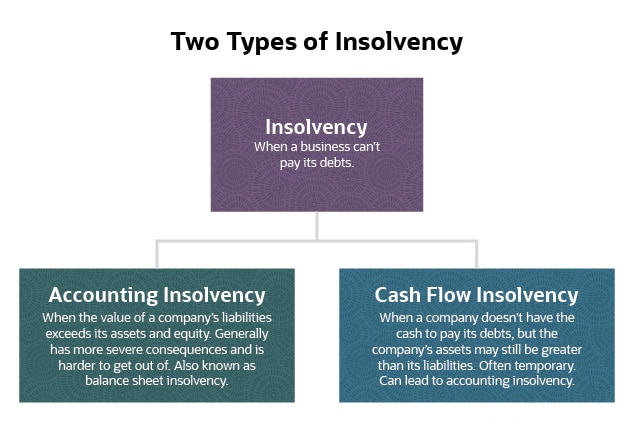What Does Insolvency Practitioner Do?
What Does Insolvency Practitioner Do?
Blog Article
Some Known Details About Insolvency Practitioner
Table of ContentsThe Ultimate Guide To Insolvency PractitionerThe Only Guide to Insolvency PractitionerThe Insolvency Practitioner StatementsSome Ideas on Insolvency Practitioner You Need To KnowInsolvency Practitioner Things To Know Before You BuyThe Greatest Guide To Insolvency PractitionerTop Guidelines Of Insolvency Practitioner
Insolvency is when obligations are more than the value of the firm, or when a debtor can not pay the financial obligations they owe. A business can end up being insolvent as a result of a number of situations that cause poor cash money flow. When faced with insolvency, a service or person can call creditors directly and restructure debts to pay them off.:max_bytes(150000):strip_icc()/Liquidation-4193561-Final-699e67d885c243c39cac2985b16d51cb.jpg)
Service owners might contact financial institutions directly and restructure financial obligations into more manageable installations. Financial institutions are usually responsive to this approach because they desire to be paid off and stay clear of losses, even if the settlement is on a postponed schedule.
The owner creates a proposition outlining how the financial debt may be reorganized using price reductions or various other strategies for support. The proposal shows financial institutions exactly how business might generate enough cash circulation for profitable operations while paying its debts. Usually, a forgiven financial obligation may be thought about revenue by the Irs (INTERNAL REVENUE SERVICE).
About Insolvency Practitioner
When an organization has to pay raised prices for items and services, the company passes along the cost to the consumer. Rather than pay the raised expense, several customers take their company in other places so they can pay much less for a service or product. Losing clients leads to shedding income for paying the business's financial institutions.
When operations discontinue, so does the business's earnings. Some companies become insolvent due to the fact that their goods or services don't progress to fit consumers' altering demands.
The Main Principles Of Insolvency Practitioner
Costs exceed revenues and costs continue to be overdue. Kinds of bankruptcy include cash-flow insolvency and balance-sheet insolvency. Cash-flow bankruptcy happens when a firm has the possessions to cover their financial obligations yet they are in the incorrect form, such as genuine estate rather than liquid funds. Balance-sheet insolvency, on the various other hand, suggests an absence of assets in any type of kind to cover debts.
The IRS states that an individual is bankrupt when the overall liabilities exceed total assets. Insolvency Practitioner. A bankruptcy, on the various other hand, is a real court order that illustrates just how an insolvent person or business will certainly pay off their financial institutions, or exactly how they will market their possessions in order to make the payments
9 Easy Facts About Insolvency Practitioner Described
If that circumstance expands longer than anticipated, it can bring about insolvency. When a firm or person is financially troubled, they can not fulfill their financial responsibilities. Solvency is when you have adequate funds to cover the repayments you owe. A firm is taken into consideration solvent when they have a lot more assets than responsibilities.

Comprehending the variables that can cause insolvency, such as overspending, can aid you stop insolvency and its repercussions.
Insolvency Practitioner Fundamentals Explained
It is well recognized that directors and police officers of companies (and supervisors of limited obligation business) owe fiduciary duties to their organizations and their investors (or members). These fiduciary obligations are defined by state statutes and, though there are variants from one state to another, they usually include a task of commitment and an obligation of treatment.
The obligation of treatment requires directors and police officers to exercise diligence, to make informed decisions, and to act in excellent faith to ensure that their activities remain in the ideal interest of the business. Though past the range of this discussion, some states allow these tasks to be restricted either by so keeping in mind in the organizational papers or adhering to other requirements.
Getting The Insolvency Practitioner To Work

Be careful regarding providing investors preferential treatment at the expense of lenders (e.g., accrediting and funding a returns or a supply redemption). Be careful about preferential therapy between classes of shareholders. Make sensible efforts to discover all the realities before taking a certain training course of activity; supervisors should genuinely think that any kind of choices made are in the ideal interests of the corporation in its entirety (i.e., choices will certainly be original site examined in knowledge taking into account the result of such activities on the company).
In any type of insolvency or bankruptcy case, settlements made to particular financial institutions at the cost of other creditors can be clawed back, specifically if there is some connection between the firm and the creditor. Consider suggesting at an annual investor conference a knockout post (or any other meeting of shareholders) a resolution attesting that all prior business decisions and actions taken by the supervisors and policemans of the firm were absorbed great faith after a workout of practical treatment.
5 Easy Facts About Insolvency Practitioner Explained
Completely disclose any personal or service connections with parties beyond of purchases involving the firm to avoid the appearance of a conflict of rate of interest. In assessing possible fund raising purchases or a sale of assets of the struggling company, understand that these purchases may be inspected later in light of any subsequent growth of supervisors' fiduciary tasks to consist of creditors.
Report this page